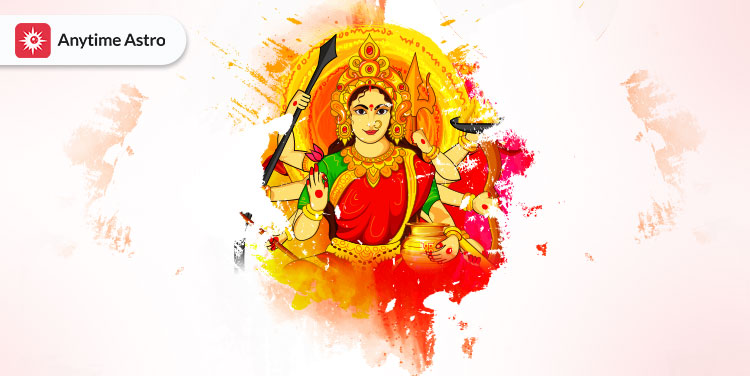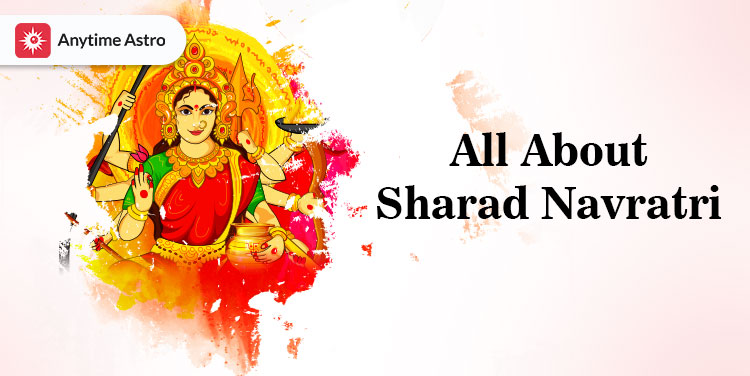Sharad Navratri, also referred to as Sharadiya Navratri, is a 9-day festival honoring the 9 Avatars of Shakti (Mother goddess). It occurs in Ashwin Month's Shukla Paksha, which normally falls in September or October on the Gregorian calendar. Sharada represents Autumn and so Sharad Navratri is the most well-known and important of all Navratris. Thus, this Navratri is also referred to as “Maha Navaratri”.
Navratri, which literally translates to “Nine Nights”, is a celebration of the nine manifestations of the Devi Adiparashakti (the supreme being, creator, and destroyer of the elements). Even during the times of the Ramayana and Mahabharata, gods and deities observed Sharad Navratri.
As per the Hindu calendar, the main Navratri of the year occurs during the month of Ashwin during the season (Ritu) of Sharad, and so the names suggest ‘Sharad Navratri’ or ‘Sharadiya Navratri’. It is assumed that only during this period of the year did Durga descend on the earthly plane to satisfy the wishes of all her devotees. Hence, this is held as the most important, popular, and celebrated Navratri of the year.
Ghatasthapana 2024 Date and Time
Sharad Navratri 2024 Date and Time (Tithi)
Shardiya Navratri Begins Date 2024- Thursday, October 03, 2024.
Shardiya Navratri End Date 2024- Satuarday, October 12, 2024
Also See: Today's Shubh Muhurat Time
Sharad Navratri Festival Calender for 2024
| Day | Date | Mother Name |
| Navratri Day 1, Pratipada | 03rd October 2024 | Maa Shailputri Puja |
| Navratri day 2, Dwitiya | 04th October 2024 | Maa Brahmacharini Puja |
| Navratri day 3, Tritiya | 05th October 2024 | Maa Chandraghanta Puja |
| Navratri Day 4, Chaturthi | 06th October 2024 | Maa Kushmanda Puja |
| Navratri day 5, Panchami | 07th October 2024 | Maa Skandamata Puja |
| Navratri day 6, Sheshi | 08th October 2024 | Maa Katyayani Puja |
| Navratri day 7, Saptami | 09th October 2024 | Maa Kalaratri Puja |
| Navratri day 8, Ashtami | 10th October 2024 |
Maa MahaGauri Puja Durga Maha Navami Puja Durga Puja Ashtami |
| Navratri day 9, Navami | 11th October 2024 |
Maa Siddhidatri Puja |
| Vijay Dashmi (Dussehra) | 12th October 2024 |
Navratri Parana Vijay Dashmi Durga Visarjan |
Significance of Shardiya Navratri
A variety of stories are attributed to the origins of Navratri in mythology.
The conflict between the Gods of heaven and Mahishashur (the King of Demons) had begun. All the gods, including the trinity of Brahma, Vishnu, and Mahesh combined their divine energies to give birth to "Shakti," the mother of strength, in order to defeat him. As a result, Mahishasur was formed, and after nine nights of fierce combat, Goddess Durga slew him with her strength and intelligence. Thus, the tenth day of victory is commemorated as Vijaya Dashami or the day on which good triumphs over evil.
To free Sita from Ravana's incarceration in Lanka, Lord Rama was preparing to launch a fight against the evil character. Rama worshiped the goddess Durga in order to obtain her blessings before the war began. He requested 108 lotus flowers for the pooja. To finish the count, Rama was about to sever one of his eyes when Goddess Durga arrived and presented upon him her celestial "Shakti." The fight was won by Rama that day.
During the Navratri, Uma, the daughter of Daksh—the ruler of the Himalayas, is rumored to return home for 10 days. This festival commemorates Uma's return to earth after her marriage to Lord Shiva.
Spiritual Significance of Sharad Navratri
Hindu astrology places a lot of emphasis on Sharad Navratri. Since projects are related to the first Navratri of the year, Magha Gupt Navratri, which falls under the sign of Aquarius, they are completed during Sharad Navratri, which falls under the successful sign of Scorpio. In fact, this is known as the harvest season and the beginning of the upcoming winter season.

Navratri: Nine Avatars of Goddess Durga
People observe the Sharad Navratri with the greatest dedication and prayer for nine nights. A different Durga Maa avatar is honored each day. As a result, followers are required to dress appropriately every day.
Day 1: Shailaputri- Pratipada
Goddess Shailaputri is celebrated on Pratipada, which falls on October 03. Putri symbolizes daughter, while Shaila depicts mountain. Deity Parvati is given prominence on this day since she is the Mountain God's daughter.
Day 2: Brahmacharini- Dwitya
Goddess Brahmacharini, an Avatar of Devi Durga who calms wrath, is celebrated on Dwitya, October 04. As a result, this Goddess is honored on the second day.
Day 3: Chandraghanta- Tritya
On October 05, which is Tritiya, worshippers worship Chandraghanta. She is said to possess a third eye and battle wicked spirits. Jasmine blossoms are used during puja to appease her.
Also See: Today Rahu Kalam Time
Day 4: Kushmanda- Chaturthi
On October 06, which is Chaturthi, Goddess Kushmanda is honored. Her name translates to "cosmic eggand," and she is renowned for bringing warmth and vitality to everyone.
Day 5: Skandamata- Panchami
Goddess Skandamata, who is in charge of Budha (the Mercury planet), celebrates Panchami on October 07. She is adored because it is said that she is tenacious and kind.
Day 6: Katyayini- Shashti
As per legend, Devi Durga took the shape of Devi Katyayani on October 08, the 6th day referred as Shashti, in order to destroy the King of Demons. Females say prayers in order to have a happy marriage and family.
Day 7: Kalaratri- Saptami
The day is specifically devoted to Goddess Kalaratri on Saptami, October 09. She is said to be terrifying and to have frightened evil spirits from all across the world. She is Lord Shani's (Saturn Planet) ruler and is Devi Kali's most terrible Avatar.
Day 8: Mahagauri- Ashtami
The eighth day of Sharad Navratri, i.e., October 10, is when Mahagauri is worshiped. On this special day, she only wears white clothing and rides a bull. On this day, Kanya Puja, a unique ceremony for young females, is held. Mahashtami or even Maha Durgashtami are named for this day. Dance, entertainment, and prayers are used to honor the day.
Day 9: Siddhidaatri- Navami
On October 11, the Navami of Sharad Navratri, Devi Siddhidaatri is honored. She has the ability to grant all of your requests, thus the ninth day is devoted to her.
Day 10: Vidhyadashami (Dussehra)
The tenth day, October 12, is set aside for Vijayadashmi after the nine days of devotion. a day when fresh beginnings in life are possible. It is also known as Vidyarambham, and it is an occasion where young people are introduced to the field of education. A crucial component of the Vijayadashmi is Sindhoor Khela.
Rituals of Sharad Navratri
- The Sharad Navratri puja officially begins with this Ghata Sthapana. The Kalash is put up and Maa Durga idols or statues are set up on crimson chowkis.
- It is covered with flowers and Ganga Jal. Mango leaves with a coconut on top in a roll.
- The worship of Durga begins with the lighting of a Diya in front of the goddess. The key to this process is calling upon the goddess Durga.
- It is considered lucky to recite prayers and invoke Durga Maa because it is believed that she would enter your home, provide illumination, and bestow blessings on you and your family.
- To carry out the ceremony of Navratri Puja, you must give Bhog, flowers, fruits, diya, and so on.
- The rituals end with performing Aarti and ringing bells to seek Maa Durga's blessings.
- On the ninth day of Navratri, the concluding day of the festival, nine girls between the ages of 5 and 12 are invited, and food is prepared for them. As they are considered the 9 manifestations of the Goddess.
Final Thoughts
In Hinduism, the Sharad Navratri festival is extremely important because it symbolizes the victory of good over evil. During these nine days, which are regarded as holy and pious, it is strictly forbidden to consume alcohol, meat, onions, or garlic. People participate in rites, rituals, yagnas, and other activities and refrain from engaging in any illegal conduct.
To learn more about the rituals and puja of Sharad Navratri, get in touch with Astrologers.






Leave a Comment